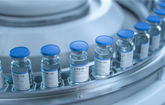CHICAGO, April 10, 2025 /PRNewswire/ -- The global organ on a chip market was valued at US$ 157.06 million in 2024 and is expected to reach US$ 2,238.28 million by 2033, growing at a CAGR of 34.34% during the forecast period 2025–2033.
Request Sample Pages: https://www.astuteanalytica.com/request-sample/organ-on-a-chip-market
By 2024, recent real-world milestones underscore how organ-on-chip technology has shifted from an academic pursuit to a bona fide industry disruptor—one increasingly validated by regulatory authorities. Emulate, Inc.'s collaboration with the U.S. Food and Drug Administration (FDA) exemplifies this evolution. In 2021, FDA scientists joined a pilot program assessing Emulate's Liver-Chip to predict drug-induced liver injury, following earlier collaborations focusing on Intestine-Chip devices for toxicological analysis. Although not yet replacing mandatory preclinical standards, these studies have yielded actionable insights for refining safety protocols, marking a key step toward broader regulatory acceptance.
Beyond Emulate, CN Bio Innovations has also forged a Cooperative Research and Development Agreement (CRADA) with the FDA, exploring advanced hepatic models through its PhysioMimix platform. In one high-profile deployment, CN Bio's liver-on-chip system was used to evaluate viral hepatitis progression under near-physiological conditions. Early data from these studies, disseminated in peer-reviewed journals and FDA public updates, suggest a growing regulatory openness to organ-on-chip data within drug evaluation processes.
Crucially, such FDA collaborations serve as validation touchstones for stakeholders in the Organ-on-a-chip market. They spark interest in formalizing guidelines for organ-on-chip use in Investigational New Drug (IND) submissions—particularly for toxicity screens. As pilot findings trickle into official recommendations, market watchers anticipate a gradual mainstreaming of organ-on-chip data in regulatory dossiers, reinforcing the technology's real-world viability and reshaping preclinical assessment across pharma pipelines.
Pioneering Companies: Emulate, Mimetas, CN Bio, And TissUse Lead Advances
Four companies stand out in cementing Organ-on-a-chip market for commercial and research use—each contributing unique technological hallmarks and forging strategic collaborations that fuel adoption.
Emulate, Inc. remains at the forefront with its Human Emulation System, consistently partnering with top-tier pharma clients (including Johnson & Johnson and Pfizer) to provide validated models for lung, intestine, and liver research. Their 2023 pilot with the FDA's Center for Food Safety and Applied Nutrition marks a milestone in shifting regulatory perspectives toward microphysiological platforms.
Mimetas, recognized for its OrganoPlate platform, champions high-throughput screening applications tailored for drug discovery. By using gradient-based microfluidic techniques, the company's system enables researchers to culture multiple tissue types simultaneously for compound efficacy tests. Notably, Roche has reportedly employed Mimetas' technology in immuno-oncology programs, signaling an industry-wide shift toward more complex yet scalable models.
CN Bio Innovations has gained traction in the Organ-on-a-chip market through its PhysioMimix series, featuring multi-organ designs that help simulate systemic interactions—particularly relevant in studying metabolic disorders. In a 2022 partnership with Gilead, CN Bio tested novel antiviral compounds on advanced liver modules, illustrating how close-to-human models can accelerate early go/no-go decisions.
TissUse, based in Berlin, pushes boundaries with its 'Multi-Organ-Chip' capable of hosting multiple organ compartments in a single microfluidic circuit. Its collaborative research under Europe's Horizon 2020 framework addresses complex disease states that demand an integrative system, such as nonalcoholic steatohepatitis (NASH) and polypharmacy scenarios. Collectively, these pioneers pave the path for new entrants, continuously refining design, throughput, and validation to meet the evolving demands of global healthcare R&D.
Pharma Collaborations: Strategic Partnerships Fuel Widespread Global Translational Organ-On-Chip Adoption
Pharmaceutical giants are increasingly forging alliances with innovators in the Organ-on-a-chip market to align cutting-edge translational models with high-stakes R&D goals. Since late 2022, high-profile collaborations—such as AstraZeneca's partnership with Emulate, Inc. and Roche's ongoing work with Mimetas—have demonstrated the willingness of major drug developers to invest heavily in these emerging systems. A driving factor: the recognition that an unmet need persists in translating preclinical findings to clinical outcomes, especially for complex diseases like oncology, fibrosis, and autoimmune disorders.
In practice, these partnerships across the global organ-on-a-chip market are multifaceted in the market. Pharma companies often provide real-world drug candidates and clinical data repositories, enabling organ-on-chip start-ups to optimize their platforms with disease-specific parameters. Meanwhile, innovative organ-on-chip developers contribute microengineering expertise, novel biomimetic designs, and advanced sensor integration—collectively generating data sets with heightened physiological relevance. This exchange ensures that both sides gain: pharmas acquire more predictive, mechanistic insights to refine trial design, while organ-on-chip companies accrue the validation required to stand out in a rapidly crowding marketplace.
Advanced Applications: Oncology, Neurodegenerative Diseases, Lung Models, And Beyond Unfold
Once confined to simpler liver or kidney constructs, organ-on-chip platforms now cater to an expanding gamut of therapeutic areas—giving Organ-on-a-chip market strategists new arenas for impactful R&D. Oncology leads the charge, with tumor-on-chip setups that capture interactions among cancer cells, stromal cells, and immune components. Mimetas' OrganoPlate, for instance, has been employed by Pfizer to replicate solid-tumor microenvironments. These advanced setups permit real-time observation of tumor growth dynamics and immunotherapeutic responses, providing earlier insights on mechanism-of-action than typical 2D assays.
In neurology, brain-on-chip systems—complete with functional blood-brain barriers—are attracting attention. Emulate's Neurovascular Unit Chip, tested by the Wyss Institute in 2022, has shown promise in modeling disease-related changes associated with Alzheimer's pathology, including amyloid beta accumulation across engineered endothelial layers. As neurodegenerative disorders challenge conventional in vitro approaches, these microfluidic devices offer a more nuanced path to studying drug penetration, neuronal viability, and synaptic function.
Meanwhile, lung-on-chip interfaces remain top-of-mind in the Organ-on-a-chip market, particularly for conditions like chronic obstructive pulmonary disease (COPD) and pulmonary fibrosis. TissUse's multi-tissue circuit includes a sophisticated alveolar compartment that mimics airflow shear stress—helping evaluate the effectiveness of inhaled therapeutics under near-physiological conditions. Beyond these domains, CN Bio's multi-organ permutations increasingly target metabolic syndromes, bridging gut, liver, and pancreas models to tackle diabetes and obesity research. Collectively, these specialized applications reflect how organ-on-chip devices aren't just placeholders—they're catalysts for nuanced, condition-specific breakthroughs deeply influencing drug pipeline decisions worldwide.
Technical Innovations: Microfabrication, Sensor Integration, And Validated 3D Tissue Models
Advances in microfabrication and sensor technologies are reshaping the capabilities of organ-on-a-chip market potential, delivering ever more precise insights for R&D strategists. In the past two years, 3D bioprinting and high-resolution soft lithography methods have significantly enhanced microchannel architecture, enabling more physiologically accurate flow dynamics. Companies like TissUse and Mimetas capitalize on custom polymer formulations that offer superior optical transparency and greater mechanical stability—facilitating extended tissue viability necessary for longitudinal toxicity or disease progression studies.
Simultaneously, sensor integration is becoming a critical differentiator in the organ-on-a-chip market growth. Wherein, Emulate's chips come embedded with micro-sensors that track factors like electrical impedance, metabolic byproducts, and mechanical strain in real time—vital for analyzing phenomena such as arrhythmia in heart-on-chip models or barrier permeability in gut-on-chip setups. These 'lab-on-chip' sensor arrays convert biological events into continuous data streams, capturing subtle events (e.g., infiltration of immune cells or changes in tissue stiffness) that may be missed in static endpoints.
Market Enablers: Funding, Incentives, And Ethical Pressures Driving Global Adoption
Comprehensive funding ecosystems, policy incentives, and rising ethical scrutiny of animal testing collectively shape an environment ripe for Organ-on-a-chip market growth. Venture capital firms specialized in biotech have increasingly funneled resources into start-ups with validated organ-on-chip prototypes. For example, Series B rounds of $20 million or more were reported in 2023 for multiple microphysiological system developers, reflecting investor confidence in the technology's scalability and disruptive potential.
On the governmental front, grants from groups like the National Institutes of Health (NIH) Tissue Chip Program have underwritten collaborative projects that expedite technology refinements. European agencies, under Horizon Europe, have also financed cross-border consortia to accelerate the standardization of organ-on-chip protocols in preclinical safety evaluations. This infusion of public funds encourages academic labs to spin out advanced solutions and fosters synergy with private corporations eager for clinically relevant, ethically favorable alternatives.
Ethical pressures add further impetus to the growth in the Organ-on-a-chip market. Wherein, aging populations and the rise of complex chronic diseases have illuminated limitations in existing animal models, fueling arguments for more human-relevant techniques. Regulatory moves—such as the U.S. FDA Modernization Act 2.0, signed in late 2022—open the door for non-animal approaches in investigational drug testing. In Europe, citizen-driven movements to reduce lab-animal usage continue altering both public opinion and policy guidelines. Consequently, from a market decision-maker standpoint, investing in organ-on-chip platforms can present both an ethical advantage and a compelling R&D differentiator, aligning corporate social responsibility goals with scientific progress.
Risk Factors: Manufacturing Complexities, Protocol Standardization, And Scalability Challenges Persist
Despite strong momentum, Organ-on-a-chip market poses challenges that require strategic foresight from corporate decision-makers. Manufacturing intricacies loom large—producing chips that harbor complex microfluidic layouts, multiple cell types, and real-time sensor arrays demands specialized infrastructure seldom found in traditional biotech labs. While established players like Emulate and Mimetas have streamlined certain fabrication steps (e.g., polymer casting, multi-layer bonding), scaling to meet global demand without sacrificing reproducibility remains a work in progress. Consequently, protocol standardization remains inconsistent. Pharmaceutical partners might receive slightly different readouts for the 'same' lung model produced by two different labs. These discrepancies stem from variations in cell sourcing, perfusion media, and dynamic flow settings. Regulators have flagged standardization as a pivotal factor for broader acceptance of organ-on-chip data. Leading companies and academic consortia continue to publish 'best practice' guidelines, but the industry collectively agrees more harmonization is essential.
At last, scalability can be financially daunting. Some start-ups in the organ-on-a-chip market lack the means to produce thousands of chips in rapid succession, limiting widespread adoption for large-scale screening campaigns. Contract research organizations, which frequently handle such high-volume requests, might be hesitant to ramp up organ-on-chip capacity without validated, off-the-shelf solutions. These realities can deter risk-averse pharmaceutical stakeholders from immediate, large-scale implementation, preferring incremental pilot programs over full deployment. Nonetheless, many experts predict that as the organ-on-chip ecosystem matures—and manufacturing lines become more automated and standardized—these hurdles will subside, unlocking broader commercial uptake and more robust data sets across therapeutic areas.
Inquiry Before Buying: https://www.astuteanalytica.com/inquire-before-purchase/organ-on-a-chip-market
Future Opportunities: Transforming Preclinical Research And Accelerating Personalized Therapy Discovery
Looking ahead, multiple developments suggest that Organ-on-a-chip market will continue to redefine the preclinical landscape and open new frontiers in precision medicine. Multi-organ platforms, such as TissUse's HUMIMIC technology, are inching closer to integrated microphysiological networks that recreate the systemic interplay seen in actual patients. These linked organ compartments offer a route to study drug distribution, metabolism, and off-target toxicity with far greater fidelity, potentially transforming how pipeline molecules progress through Phase I or Phase II trials.
A parallel evolution involves patient-derived microtissues, which harness induced pluripotent stem cells (iPSCs) or primary biopsies to cultivate personalized disease models on chips. Although development costs remain nontrivial in the organ-on-a-chip market, early pilots in oncology and rare genetic disorders show encouraging potential. To that end, Emulate has embarked on pilot projects with leading cancer research centers to create patient-specific tumor chips that predict therapy responsiveness, aiming to eventually influence real-time clinical decisions.
For market decision-makers, these scenarios present unprecedented opportunities. Companies that position themselves now—by investing in robust manufacturing, forging regulatory alignment, and adopting best-in-class data analytics—stand poised to reap competitive advantages as organ-on-chip systems become embedded throughout drug discovery and development workflows. In the longer term, as ethical considerations and molecular complexity drive innovation, fully personalized therapy pipelines could rely on organ-on-chip readouts to optimize dosing regimens, minimize adverse effects, and ensure faster patient benefits. In short, technology's trajectory suggests a fundamental reshaping of R&D decision-making, offering a path to safer, more precise, and more cost-effective therapies for patients worldwide.
Global Organ on a Chip Market Key Players:
- Emulate, INC.
- Mimetas B.V.
- Valo Health
- AIM Biotech Pte. Ltd.
- AxoSim, Inc.
- InSphero
- CN Bio Innovations Ltd
- SynVivo, Inc.
- TissUse GmbH
- AlveoliX AG
- Other Prominent Players
Market Segmentation:
By Product & Services
- Products
- Instruments
- Organ-on-a-Chip Devices
- Liver-on-a-Chip
- Lung-on-a-Chip
- Intestine-on-a-Chip
- Kidney-on-a-Chip
- Heart-on-a-Chip
- Others
- Services
By Application
- Drug Discovery
- Toxicology Research
- Others
By End Users
- Academic and Research Institutes
- Pharmaceutical & Biotechnology Companies
- Others
By Region
- North America
- Europe
- Asia Pacific
- Middle East & Africa (MEA)
- South America
Get Free Customization on this Report: https://www.astuteanalytica.com/ask-for-customization/organ-on-a-chip-market
Explore More Reports:
Biosensors Market: By Type (Sensor Patch and Embedded Device); Product Type (Wearable Biosensors and Non-Wearable Biosensors); Technology (Electrochemical (Amperometric, Potentiometric, Voltammetric, Others), Physical (Piezoelectric and Thermometric), Optical); Application (Medical (POC Testing, Cholesterol, Blood Glucose, Blood Gas Analyzer, Pregnancy Testing, Drug Discovery, Infectious Disease), Bioreactor, Agriculture, Environment, Research & Development, Security and Bio-Defense, Others); End Users (Healthcare & Diagnostics, Food and Beverage, Pharmaceutical, Agriculture, Cosmetics, Environmental, Others); Region— Market Size, Industry Dynamics, Opportunity Analysis and Forecast for 2025–2033
Brain Computer Interface Market: By Component (Hardware, Software, Services); Type (Invasive BCI, Non-Invasive BCI, Partially Invasive BCI); Application (Healthcare, Gaming & Entertainment, Smart Home Control, Education & Research, Military & Defense, Others); Region—Market Size, Industry Dynamics, Opportunity Analysis and Forecast for 2025–2033
Mass Spectrometry Market: By Product Type (Instruments and Consumables & Services); Technology (Hybrid Mass Spectrometry (Triple quadrupole (Tandem), Quadrupole Time-of-Flight (Q-TOF), Fourier Transform Mass Spectrometry (FT-MS)), Single Mass Spectrometry (Ion trap, Quadrupole, Time-of-Flight (TOF)); Application (Proteomics, Clinical Medicine, Mass Spectrometry Imaging, Geology And Space Science, Forensic Applications, Others); End User (Research & Academic Institutes, Pharmaceutical & Biotechnology Companies, Government & Environmental Agencies, Food & Beverage Industry, Hospitals & Diagnostic Centers); Region—Market Size, Industry Dynamics, Opportunity Analysis and Forecast for 2025–2033
Industrial Coatings Market: By Product (Powder Based, Solvent Borne, Water-Borne, Others), Material (Epoxy, Acrylic, Alkyd, Polyurethane, Polyester, Others); Technology (Conventional Coatings, Nano Coatings, Electrocoat, High-Solids Coatings); End User (Electronics, Aerospace, General Industrial, Marine, Mining, Power Generation, Automotive & Vehicle Refinish, Oil & Gas, Others); Region—Market Size, Industry Dynamics, Opportunity Analysis and Forecast for 2025–2033
About Astute Analytica
Astute Analytica is a globally recognized market research and advisory firm, delivering data-driven insights and strategic intelligence to organizations worldwide. We offer comprehensive research solutions across a wide range of industries, including technology, healthcare, chemicals, semiconductors, FMCG, and more.
Our reports provide in-depth analysis of market trends, competitive landscapes, emerging opportunities, and technological advancements, empowering businesses to make informed decisions in an evolving global environment. Supported by a team of seasoned analysts, economists, and industry experts, we are committed to delivering accurate, timely, and actionable insights.
At Astute Analytica, client success is our priority. We offer customized research solutions that are both cost-effective and tailored to meet the unique needs of our clients.
Contact:
Mr. Vipin Singh
Astute Analytica
500 N Michigan Ave, Suite 600
Chicago, Illinois, United States
USA: +1-888 429 6757
Email: sales@astuteanalytica.com
Visit our Website: https://www.astuteanalytica.com/
Japan Website: https://www.reportocean.co.jp/
Expert Network Platform: https://www.astuteconnect.com/
Logo: https://mma.prnewswire.com/media/2643300/Astute_Analytica_Logo.jpg







Share this article